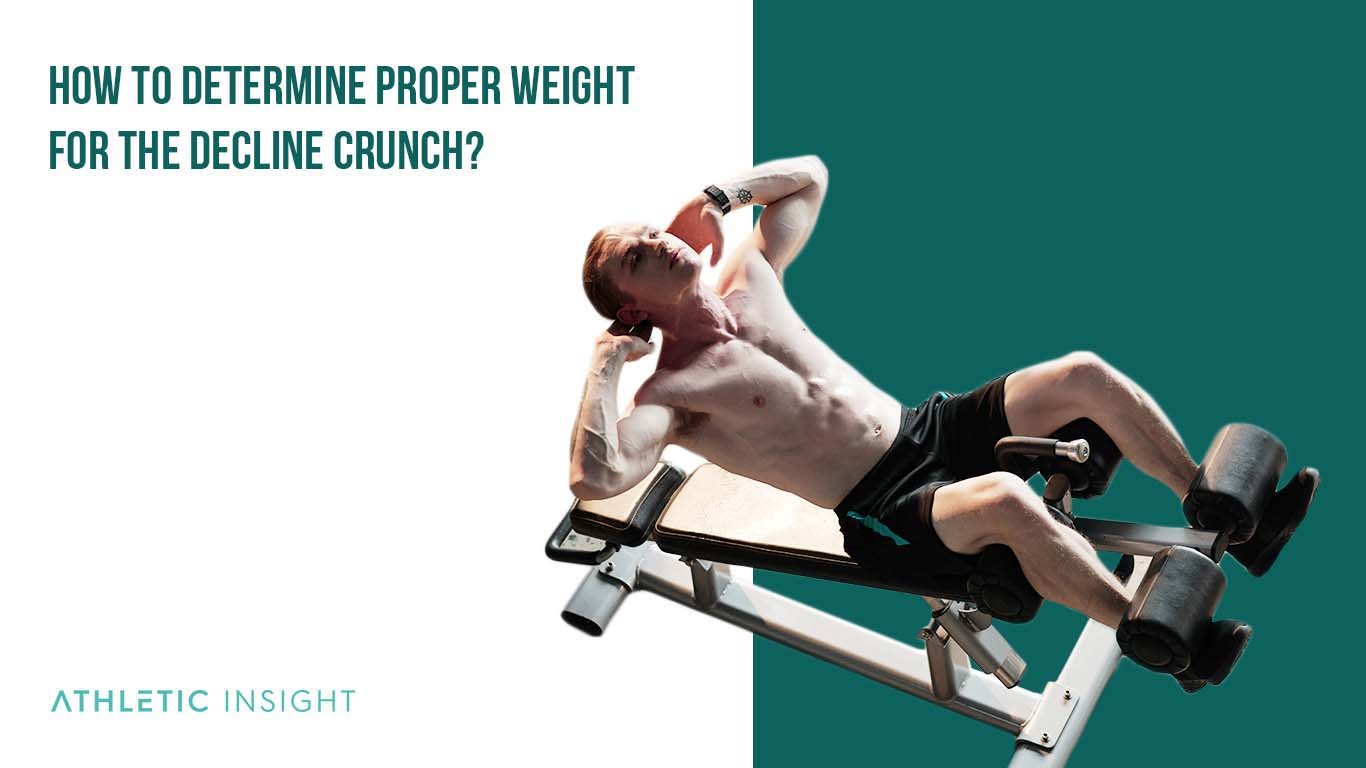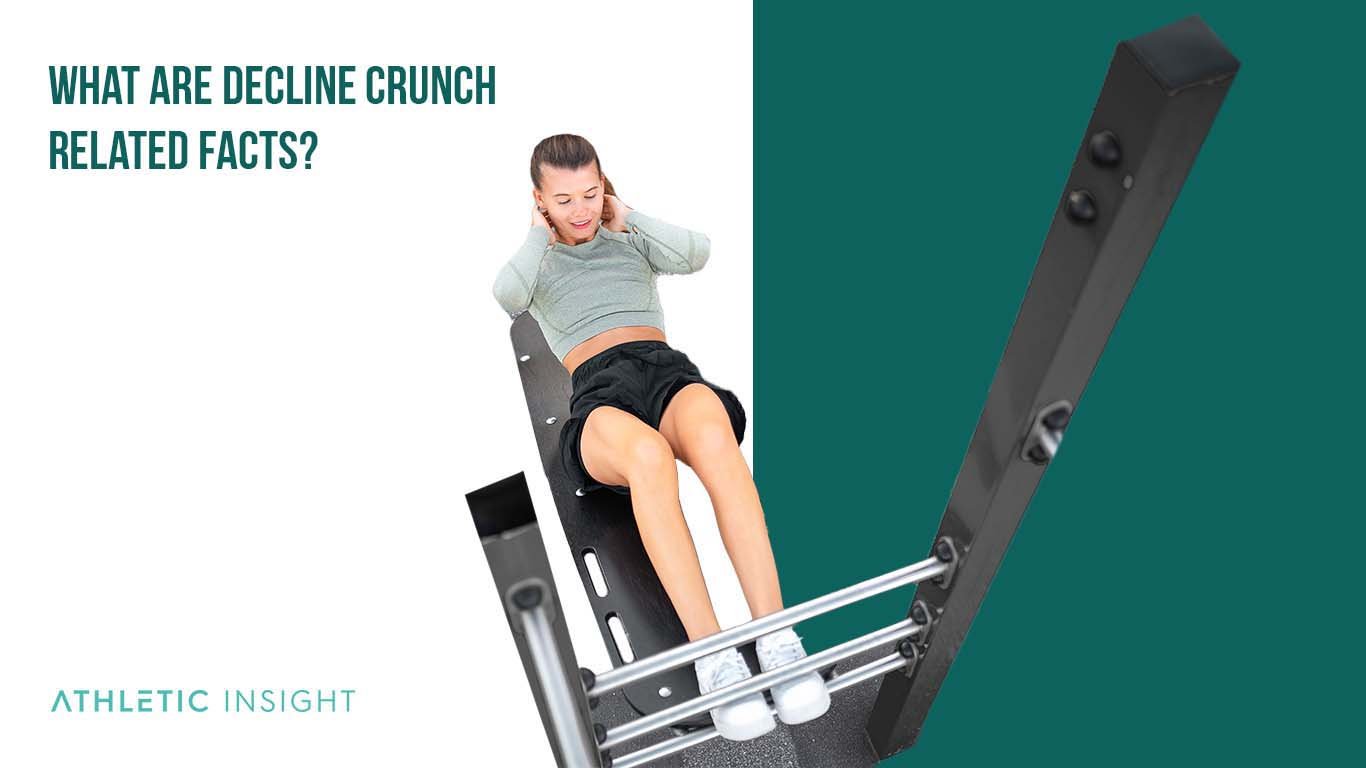If you’re looking to get in shape, a proper core workout needs to be a key component of your exercise routine. The following article will teach you how to master the decline crunch.
A decline crunch is a situp done with your head starting lower than your legs. The benefit of the decline crunch is that it forces your body to go through a wider range of motion than a traditional crunch.
The primary muscles involved in the decline crunch are the rectus abdominis–or six-pack muscles. In addition, the obliques, rectus femoris, and adductor muscles are assisting muscles that are also involved. There are two main decline crunch types: the decline crunch and decline situp. Other decline crunch techniques and variations include cross-body decline crunches and weighted decline crunches.
It’s important to maintain proper form when performing a decline crunch, to avoid common mistakes and common injuries. The main decline crunch mistakes include putting too much strain on the lower back, performing the exercise too fast, or performing the exercise with too much weight.
This article will discuss the proper technique for performing a decline crunch and the importance of proper form. We’ll also take a look at the benefits of decline crunches.
How to Perform the Decline Crunch With Proper Form?
If done correctly, Decline Crunch is an effective workout to include in your abs exercise routine. Keep your lower back flat against the bench and engage your core muscles. Here are some tips to keep your form good.
- With your back on the bench, engage your core by pulling in and tightening your lower abdominal muscles. Your lower back should flatten against the bench–do not curve your spine away from the bench, and you should not be able to fit your hand between your lower back and the bench.
- Place your hands gently on either side of your head at the temples or just behind the ears. Do not put your hands behind your head–this can cause you to pull on your neck and strain it.
- Inhale before you begin.
- Exhale as you lift your torso. This will help you to engage your core.
- Keep your gaze toward the ceiling, and your elbows open away from your torso.
- At the top of the movement (you should sit up as far as you can), hold for a count of 2, then slowly return to the starting position.
Engage your abs throughout the entire decline crunch exercise. If you feel the movement in your hips or back, adjust the bench higher until you can do the movement without feeling it in your hips.
What Are the Benefits of the Decline Crunch?
The decline ab crunch is great for targeting lower abs. Here are the main benefits of the decline crunch.
- Improves core strength
- Provides a better body aesthetic
- Improves body balance
- Improves the lower core muscles further
What Are the Mistakes for Decline Crunch Form?
You might make three main decline crunch mistakes when performing it at home.
- You are not flattening your lower back against the bench before starting.
- You are not engaging your abs throughout the exercise (relying on your hip flexors instead).
- You are pulling on the back of your head with your hands.
How to Determine Proper Weight for the Decline Crunch?
Start with no weight if you’ve never done decline bench crunches before. Learn how to do the exercise and get your body used to the motion of a decline crunch.

Once you can perform at least 12 reps with good form, you can add weight by holding a barbell plate across your chest. Add 2.5lbs or 5lbs at a time. Once you can perform 12 reps at the new weight, add more.
What Is the Importance of Grip for the Decline Crunch?
The grip strength is not a major concern as decline crunch does not involve a bar or dumbbells. However, if using a barbell plate to perform weighted crunches, hold it firmly in both hands and avoid a weight that is too heavy to hold comfortably.

Which Muscles Are Involved While Performing the Decline Crunch?
The main muscle targeted by the decline crunch is the rectus abdominis. This is the “six-pack” muscle that gives you a defined-looking stomach. It runs from the bottom of the rib cage to the top of the pubic bone, and its job is to flex the spine forward.
The assisting muscles in the decline crunch are the obliques and iliopsoas. The obliques are the muscles along the sides of your rib cage, and the iliopsoas is the muscle underneath the rectus abdominis.
How to Do the Decline Crunch?
This is how to dominate the decline crunch, decline weighted crunch, or decline oblique crunch.
- Adjust the bench’s decline angle to your skill level (30 degrees is good for beginners).
- Sit on the decline bench with your knees crossed over and ankles under the foam rollers.
- Place your hands gently behind your ears or cross your hands over your chest.
- Lay back on the seat and engage your core. Inhale.
- Exhale fully on the way up, but do not extend your stomach out.
- Slowly lay back on the bench with your shoulders and upper back off the bench.
- Repeat for the desired number of reps.
What Are the Variations of the Decline Crunch?
The two major Variations of Decline Crunch are the weighted decline crunch and oblique decline crunch. These variations are great bench crunch exercises to add to your routine. Let’s look at the main features of these variations.
- Weighted decline crunch. This is performed with a barbell weight held across your chest. The benefit is that it increases the load on your abs as you perform the exercise.
- Decline oblique crunch. Twist your torso and touch your right elbow to your left knee at the top of the movement. On the next rep, touch your left elbow to your right knee. You should strive to touch your knee with your elbow every time.
- Stability ball crunch. Improve your balance and stability while also working on your core. Place your feet flat on the floor and your upper back on a stability ball. With your hands gently behind your ears, lift your torso to an upright position, allowing the ball to roll down your spine to your lower back.
What is the Necessary Equipment for the Decline Crunch?
The only equipment necessary for a decline crunch is a decline bench. If you perform the exercise at home, you can purchase a decline bench from a sporting goods store for about $100 or you can get the best decline crunch benches.
Do not attempt this exercise without the proper equipment, as you will risk injury.
Which Muscles Will Be Most Affected by the Decline Crunch?
As stated, the rectus abdominis, obliques, and iliopsoas are the targeted muscles in the decline bench ab workout. In a regular decline crunch, the rectus abdominis will be most affected. Oblique decline crunches will affect the obliques more.
What is the Effectiveness of the Decline Crunch for Muscle Growth Compared to Squat?
The decline crunch is different from a squat, but it is still effective for muscle growth. A squat involves the core, and you should always engage your core when performing a squat, but a squat doesn’t target the core in the way that the decline crunch does.
Muscles increase in size when they are challenged. Therefore, to get the best results to improve your six-pack, you should either continually add weight to the exercise or continually increase the number of reps you perform.
What Are Decline Crunch Related Facts?
The decline crunch is a powerful exercise to include in your routine but must be performed carefully to avoid straining the lower back or neck. There are 4 reasons why the Decline Crunch is the best exercise below.

- The decline crunch is a more advanced movement than a regular crunch or sit-up.
- The decline crunch should be performed on a decline bench.
- Common mistakes made when performing decline crunches include not engaging the core fully, pulling on the head with the hands, and breathing incorrectly.
- To see the best results, challenge your muscles by continually adding weight to the movement or increasing the number of reps performed.
Is the Decline Crunch a Military Movement?
The decline crunch is not specifically known as a military exercise. However, military trainees often perform decline bench abs exercises as part of their complete exercise routine.
Is the Decline Crunch Dangerous?
The decline crunch is only dangerous if performed incorrectly or equipment used isn’t suited to the fundamental human movement. For example, always do the movement on a decline bench, and do not attempt to substitute other furniture when performing the crunching exercise.
Is the Decline Crunch Essential?
If you are a weightlifter or work out frequently, you must strengthen your core. Bench crunches are an excellent choice because they involve a full range of motion and target several muscle groups. It absolutely gives you more core strength when you’re weightlifting.
Is the Decline Crunch an Olympic Lift?
No, the crunch bench exercises are not considered an Olympic lift.
Is the Decline Crunch a Compound Exercise?
The decline crunch is a compound exercise because it involves several muscle groups: the rectus abdominis, iliopsoas, obliques, hip flexors, and lower back. However, not all crunch workouts are compound movements because they only target one muscle group. For example, crunches that you perform lying on your back with feet flat on the floor.



